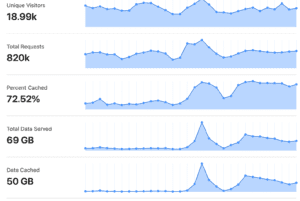Fall is a Good Time for 2026 Planning Is it time to build your next…

Does My Industrial Website Need A Content Delivery Network?
Answer: A CDN (Content Delivery Network) is something that most any website can benefit from.
From blogs to storefronts to even the often less-trafficked industrial manufacturing websites, CDNs, when configured properly, can add greatly to your SEO efforts and visitor experience by improving site performance. Content delivery networks can undoubtedly improve the speed and availability of a website. Some also offer many other great benefits from added security, portability, stability, strategic redirection, and even free SSL perfect for most industrial websites.
How Important is a Content Delivery Network to My Company Website?
If you are experiencing site outages and downtime, slow website loading times in parts of the World, or surges from unwanted traffic, chances are you could do best at this stage with an inexpensive, even free content delivery network. Some web hosts have severe limits set in resources, and even if they promise infinite bandwidth and storage, you may find that you’ve had website outages from exceeding concurrent connections or disk operations (I/O limits). Visitors are often impatient, and may leave your website before it loads after 1 to 2 seconds. Equally bad, if Google experiences difficulty indexing pages or slow load times, that will hurt your search placement and can render other SEO efforts useless. Whatever the cause, if you are at the limits of your hosting, a CDN can be a cheap or even free solution. The right cloud services can improve your website’s delivery speed, minimize server load, and increase security by blocking bots and bad actors.

Consider If Your Website’s Software Allows for a Content Delivery Network
While sites that can be self-hosted such as those built in HTML, WordPress, Drupal, Joomla, OpenCart/OsCommerce, Typo3, WebHook and the like are good candidates for Cloudflare and other Content Delivery Networks, web sites that are Websites as a Service (WSaaS) such as Zoho, Hubspot, BigCommerce, PipeDrive, Shopify and the like tend to use their own CDNs or AWS. Chances are if you are using one of the latter, this is out of your hands and already in use, or an option to enable/disable. In these cases, adding a CDN such as Cloudflare, even if it is just for the free SSL will likely slow your initial load times, if not cause major website issues. If you are using a WSaaS solution, it would be best to contact support for that solution. We specialize in many of them, and can bridge that communication gap when needed, but nothing beats the free help from the provider if it is available.
Don’t Get Oversold on your Content Delivery Network
Between the often high-pressure marketing pitches from competing network providers and big-business web developers, the owner of your common industrial manufacturing company might feel obligated to hitch up their lower-traffic website to solutions made for worldwide retailers, global news networks, or multi-billion-dollar industrial giants such as Rockwell Automation or Dover. With all they hype, a website owner might even be led to believe that the networks themselves go hand-in-hand with massive success. While a high-traffic site can suffer for failures to manage website distribution and speed, it shouldn’t be an expensive or complex issue for an industrial website hosted on a medium-to-large-business sized hosting plan.
Of course giants such as AWS & Azure, as well as the developers pushing them might tout great success stories for their customers, but one must consider that these successful companies initially had a lot of money to spend and the traffic loads to justify that spend – I.E. they were already there on top to begin with. If your company is in search of faster response for your website, improved website distribution, and added security, there are many less-expensive, even free solutions that may still more-than satisfy your website’s needs.
A successful industrial website tends to draw much less traffic and many less visitors than a successful blog, social media site, online store, or entertainment site.
Consider Your Website’s Traffic and Target Market
 The first thing to consider is the amount of traffic you realistically expect in a year. If your goals are to sell 2,000 or less machines, and to provide or give support to 10,000 or less machinists and machine operators, you might want to avoid some of the giant providers, whose price-points and complexity don’t begin to make real sense until you are purposefully serving around 3 Terrabits (375GB) or more. For a medium-to-large-sized industrial business with page sizes averaging 250KB, 30,000 visitors per month, and 5 pages per visitor a website will need about 37,500,000MB, just under 38GB, of bandwidth per month.
The first thing to consider is the amount of traffic you realistically expect in a year. If your goals are to sell 2,000 or less machines, and to provide or give support to 10,000 or less machinists and machine operators, you might want to avoid some of the giant providers, whose price-points and complexity don’t begin to make real sense until you are purposefully serving around 3 Terrabits (375GB) or more. For a medium-to-large-sized industrial business with page sizes averaging 250KB, 30,000 visitors per month, and 5 pages per visitor a website will need about 37,500,000MB, just under 38GB, of bandwidth per month.
Though some of them, such as Cloudfront (a part of AWS) offer “free” tiers to their services, that “free” is usually limited to a certain low level of http requests (traffic), a limited amount of function invocations (page rules, redirections, DDOS protection, etc.), and a lower level of gigabytes served (bandwidth).
Many major CDN providers work in this way, if they offer a ‘free’ plan at all. Some offer low-cost entry plans geared toward smaller websites with lower bandwidth, but even then their price breakdowns can be confusing. Their bottom line relies on finding ways to profit, while forcing users to streamline their websites as efficiently as possible in order to either provide less or charge more. You also may find that most services seeking to compete are seeking to only barely compete, if not offer seemingly better deals that may actually cost more in the fine print. AWS, for most, is the price-point model they build from.
A Quick Comparison Of Some of the Content Delivery Networks Out There
Fast.ly, Stackpath, are some of the cheaper competitors offer low starting plans at $50, even as low as $15 per month, but their pricing for even those low cost plans are not incredibly straightforward, but closely modeled on the AWS pricing. Google Cloud CDN offers a pay as you go program, which, CDN alone can run around $40 per month for a standard industrial website with Content Delivery Network service to 9 regions (you will however add much anything else you’d want beyond serving pages as one of many, many separate services each with their own per use fee). KeyCDN is very straight-forward as pricing goes, and comparatively cheap. Their minimum per month is currently a low $4 per month, though there is $1 more per zone beyond the first 3 chosen. If your primary interest is serving to a single country or continent, adding zones may not be necessary. A small to medium industrial website is expected to pay around $25 per month for their service, though extras are more complicated to use and the service is without the added benefit of an easy to manage Cloud Application Firewall such as Cloudflare’s.
One risk in all of these is that if your site is not *very* well optimized you could max out the bandwidth easily on large images and large or high-demand PDFs and other documents. The bigger risk in this is that you cannot predict those overages, and if you suddenly get more traffic than expected (malicious bots, runaway web crawlers, DDOS attacks, unanticipated publicity) you will be charged for whatever use above the ‘free’ threshold.
Cloudflare, another CDN provider is exceptional in that they have an absolutely free plan, providing enough bandwidth for most medium-sized industrial businesses with that plan and a whole lot of extras such as free SSL (including both Flexible SSL and Full SSL through free origin server certificates), a Cloud Firewall, DDOS Protection, DNSSEC, the ability to bypass need for paid premium DNS through page rules, javascript/HTML/CSS minification, page caching, and the ability to serve a copy of your website completely through the Content Delivery Network during brief website outages. Technically, Cloudflare is less of a Content Delivery Network and more of a reverse proxy that serves visitors cached versions of your content whenever possible from a nearby location.
With Cloudflare, Though there are add-on services you can use at all tiers, their simple pricing scale of Free, $20 per month, $200 per month, and Enterprise. If you need Enterprise service you are likely in a great place business-wise, but stand to save a *lot* of money remaining with Cloudflare. Add-on services typically come free with an upgrade to pay service, but are great extras above and beyond what is already above and beyond. One feature to seriously consider if using Cloudflare is buy their APO for WordPress sites at $5 per month. The reason? Cloudflare defaults to caching of HTTP/2.0 caching which does slow the performance of a website. They hope this this will encourage you to buy the $20 a month plan to disable this. Overall, with the free plan and without the APO, you’ll have a faster website, but never faster than a TTFB (Time to First Byte) of 600ms. Speed is incredibly important to your SEO and to your visitor experience. Though 600ms isn’t terrible, there is no doubt that faster is better and $5 a month is well-worth the spend. You may even find that the $20 a month plan saves you money on your hosting or prevents you from needing to upgrade to that next more expensive tier.
Though we are prepared to assist most any industrial business with most any cloud services provider they choose, with WordPress and other self-hosted (HTML, Joomla, Drupal, etc..) sites we often find that with the simplicity, ease of use, and ease of setup Cloudflare offers, makes Cloudflare a great find for most businesses of sizes from 1 to 100 employees who are running WordPress or other self-hosted solutions . Since we prefer for clients to have full ownership all of their digital assets, from websites to hosting to Content Delivery Networks, we also find the simple administration of Cloudlare services to be second to none, with many more exciting extras and improvements to come.
Coming soon, we’ll cover how to set your qualifying website up with Cloudflare, including how/when to install their Origin SSL certificate, creating a page rule to redirect the root domain to www, and some handy firewall configurations.
Subscribe to our Facebook page to watch for this and other handy industrial marketing updates.



